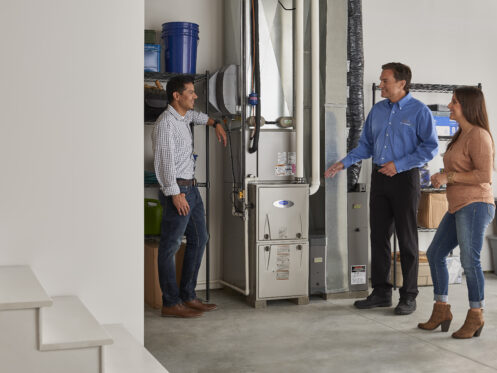Like many homeowners in Garland, TX, you’ve probably heard a lot about electric heaters in recent months. As an increasing number of states throughout the nation phase-out or outright ban gas-fired appliances, electric heaters are being lauded for their high levels of efficiency and zero-emissions designs. However, these heaters don’t perform well in all climates and they often cost more to use. While gas furnaces produce carbon monoxide and release ozone-destroying gases into the outdoor air, there’s a lot to consider before electrifying your heating system. Read on to discover the pros and cons of both electric and gas heaters.
Furnace AFUE Ratings: What They Mean and How to Use Them
All furnaces throughout the United States are assigned annual fuel utilization efficiency (AFUE) ratings. These ratings denote the amount of fuel that furnaces turn into usable heat energy. For instance, a gas-fired furnace with an AFUE rating of 95% converts 95% of the gas that it burns into heat. The rest is lost as emissions due to incomplete combustion.
At present, all gas-fired furnaces are required to have AFUE ratings of at least 80%. However, there are high-efficiency models with AFUE ratings as high as 98.5%. To compare, all electric furnaces have AFUE ratings of 100%. Thus, none of the electricity they use is wasted during the heating cycle and no combustion gases are produced.
AFUE ratings are an excellent factor to consider when you want to lower your carbon footprint and reduce your impact on the natural environment. However, having consistently high AFUE ratings doesn’t make electric furnaces the more cost-effective choice. Although natural gas prices fluctuate, they are significantly lower than electricity rates throughout the nation. Even with a mid-efficiency gas furnace, you might have lower energy bills than you would if using an electric heater.
The Benefits and Drawbacks of Electric Furnaces
Electric furnaces produce slow, consistent heat. In homes with tightly sealed envelopes and in regions with moderate winter temperatures, they’re a practical and overall affordable choice. Given that they aren’t combusting fuel or producing harmful exhaust, electric furnaces sustain a lot less wear than gas-fired models. This leads to longer lifespans, fewer problems throughout their lifespans, and a lot less maintenance overall.
All fuel-combusting appliances produce carbon monoxide (CO). This is an odorless, colorless gas that displaces oxygen in the blood. Breathing it in can cause headaches, nausea, vomiting, dizziness, and confusion. If left unchecked, CO leaks can also lead to permanent organ and brain damage or even death. Installing an electric furnace is a step towards eliminating CO-producing appliances from your home. However, to get rid of them completely, you’ll also need to replace any gas-fired water haters with electric models.
Electric furnaces cost a bit more than gas furnaces. This is true of both their upfront costs and their installation costs. This is especially true when converting from a gas-fired appliance to an electric one rather than installing an electric heater in brand-new construction. Electrifying a natural gas heating system often entails:
- Capping off natural gas lines
- Modifying HVAC air ducts to accommodate new equipment
- Choosing a new furnace storage area
- Sealing off existing venting systems
However, while many mid-efficiency gas furnaces are expected to last just 15 to 20 years, even entry-level electric furnaces can last up to three decades.
The Benefits and Drawbacks of Gas-Fired Furnaces
Gas furnaces burn hot and they release heat at a more even and steady pace than electric furnaces do. They’re ideal for exceedingly cold environments. In Garland, where winter temperatures often dip as low as 35 degrees Fahrenheit, a gas furnace can reliably perform. In this climate and in areas with temperatures much lower than this, some electric furnaces could struggle to heat entire homes at all. Not only is this problematic for building residents, but it can also increase the risk of freezing pipes and pipe ruptures.
High-efficiency gas-fired furnaces minimize energy waste and the production of harmful emissions like CO by sending combustion gases into secondary heat exchangers. While the majority of heat produced by burning fuel is extracted in their primary heat exchangers, their secondary heat exchangers extract another 5% to 12%. This is beneficial to both the environment and consumers’ wallets. However, it also means having another heat exchanger to maintain and repair.
Many of the drawbacks of natural gas furnaces are effectively mitigated with proper installation, routine maintenance, and timely repairs. For instance, gas-fired furnaces are mandatorily attached to venting systems. These vents route exhaust gases like carbon monoxide outdoors so that they never have the chance to harm building residents. During annual furnace maintenance service, our technicians check these systems for crushed sections, blockages, and leaks. Throughout the year, homeowners can take steps to keep their outside exhaust vents clear. Moreover, by installing carbon monoxide detectors throughout their homes, homeowners can get early alerts of CO exposure before the resulting symptoms and side effects spiral out of control. By working with a reputable HVAC company, you can greatly minimize all risks associated with gas furnace use.
In Garland, gas furnaces remain the top choice for home heating for a variety of reasons. Most older properties already have the infrastructure to support these units. The high heat and even, consistent heating they provide are ideal for local conditions. More importantly, the cost of fueling gas furnaces is significantly lower than the cost of powering electric ones.
Upgrading to a High-Efficiency Gas Furnace
Although there are high-efficiency furnaces with AFUE ratings of 98.5%, these installations aren’t suitable for all homes. Given that these models come with secondary heat exchangers, they’re often significantly larger than mid-efficiency furnaces. For these and other reasons, these furnaces often require all-new storage areas or significant modifications of existing furnace locations.
Ductless Mini-Splits and Central Heat Pumps as Electric Heaters
It’s impossible to talk about electric heaters without mentioning heat pumps. Whether installing a ducted heat pump or a ductless mini-split, you can have a heater that operates at efficiency levels of over 100%. In fact, some models produce three to four times more heat than they consume in electricity.
Heat pumps and ductless mini-split heat pumps are functionally identical to air conditioners in winter. In summer, they work in reverse and transfer heat from the outdoor air inside. These units don’t burn fuel or send emissions into the outdoor air. They’re also an excellent alternative to CO-producing appliances when you want to eliminate the risk of carbon monoxide exposure entirely.
The primary drawback of heat pumps is their declining performance in exceedingly cold weather. When outdoor temperatures fall below freezing, most heat pumps struggle to source enough heat. You can overcome this problem by choosing a high-performance, low-ambient heat pump and installing a base pan heater at outdoor coils to prevent icing. However, if Garland ever experiences a lower-than-normal cold snap, you may need a secondary heating source to keep everyone warm and prevent your pipes from freezing.
Residents of Garland, TX can count on us for superior heating, cooling, plumbing, and indoor air quality services. We also provide slab leak repairs, tankless water heaters, and sump pumps. Call On Time Experts now to schedule an appointment.

